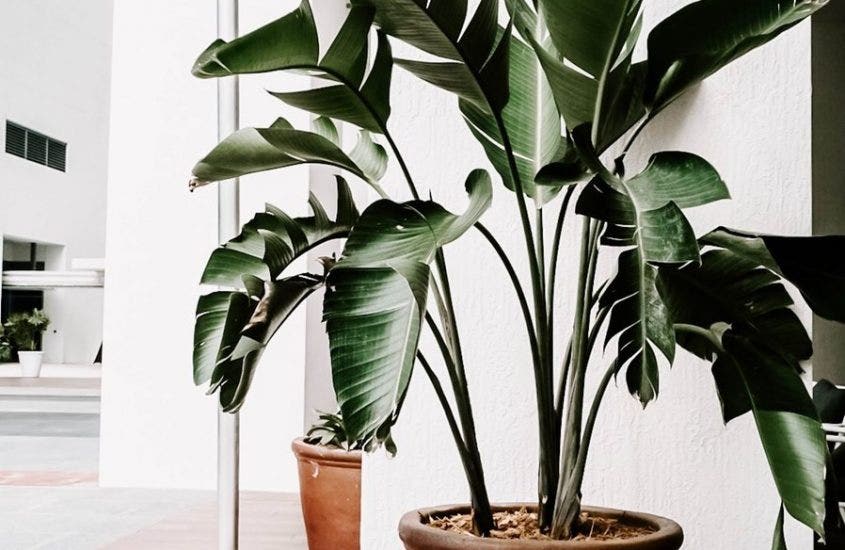12 Best Air Purifying Plants for Your Home

It’s growing increasingly popular for people to move air purifying plants into their homes. Plants for purifying air are beautiful additions to your home and help add some colors to it as well.
Bringing in plants for air purifying can also become conversation starters and are easy to incorporate in your home. You can add some nice variety if you put them in different styled planter pots, too.
Let’s go over the benefits of having air purifying plants in the house, which air cleaning plants to choose, and where to put them to maximize growth.
Table of Contents
Plants Can Purify The Air In Your Home
It may seem obvious, but there are plenty of benefits to having an air purifying plant in your home. It will produce oxygen and, in some cases, purify your indoor air!
There’s a study put out by NASA that details some of the best air purifying plants, and also the best plants for indoor usage. After all, astronauts need air to breathe, and there’s no air in space!
The study mentioned several toxins present in enclosed spaces that aren’t necessarily harmful to humans in small quantities. But, if there is no filtration system, like on the International Space Station for example, buildup can be harmful.
Some of these toxins include benzene, which may irritate skin and eyes, trichloroethylene, which in high volumes is classified by the National Cancer Institute as a potent liver carcinogen, and formaldehyde, which can irritate the mucous membranes of the eyes, nose, and throat.
Learn more about the detrimental effects of indoor air quality right here.
As a general rule of thumb, plants that have a larger surface area will be able to produce the most amount of oxygen, and also purify your air.
However, there are some exceptions here and there, such as the amount of leaves a plant may produce. So, some plants with smaller surface areas per leaf, but have more leaves on their trunk and branches will produce more oxygen and purify more air in your home.
Some people may want more desert plants in their home, which may cactus and smaller succulents. So, adding a snake plant will keep those desert vibes alive and help purify the air too. Some people may be looking for more of a garden theme in their home, in which case you’ll want leafy plants.
Always keep in mind that light is absolutely essential for the growth of your indoor plants. You will need a viable set of LED grow lights in order to make sure that your plants grow up healthy, as they mimic natural sunlight.
A plant or two may not be enough to purify your air. So, test your indoor air quality to see if you need to research more ways to purify your air.
So, What’s The Best Way To Grow Plants Indoors?
If you’re already an avid plant grower and you know the best ways, you’re all set to move on! We’ll touch on some of the best tips and common mistakes some people make when trying to grow their air purifier plant.
Potting Soil Reigns
Using potting soil gives your plants the best chance to survive if it’s in a container. They need loose soil and filtration at the bottom of the pot; water can soak in through the soil and any excess gets filtered out.
Outdoor soil doesn’t work as well, and the same goes for compost. Buying a large bag of potting soil will suffice all your needs and you can repot plants if necessary.
Low Light Means Some Light
When we say some plants will thrive in lower lighting scenarios, such as a bathroom or an east or west facing window, we don’t mean that this plant needs no light at all! All plants need light; some need more or less than others.
If you see a struggling plant, put it in a higher sunlight area for a few days and see what happens. Direct sunlight may help, but may also dry out your plant. It’s best to have your plant in an area that will get some direct and mostly indirect light.
Start With One, Then Move To Some!
When I got my first plant, a little succulent, I was so stoked to have one. I immediately got another two plants and ended up killing one of them…it was a very frozen, watery death (I accidently left it overnight in my car during the winter….). I decided that maybe I wasn’t a great plant owner.
But, I have bought more since then and discovered that the key is to get a new one every couple of months.
Once you figure out how to grow certain plants and keep them alive, you’re ready to move on to another!
So, we will now get into the plants for the house that purify your air. We’ll list what type of plant it is, and tell you how much of what harmful pollutants it removes in the air. Then, you can make your buying choices based on this article.
Bamboo Palm
- Scientific name: Chamaedorea seifrizii
- Micrograms removed per 24 hours
- Formaldehyde = 76,707
- Trichloroethylene = 16,520
- Benzene = 34,073
First on our list is the bamboo palm; this plant removes the most amount of combined harmful toxins of plants on our list. Not only is it incredibly efficient in cleaning the air, but it’ll also look beautiful in your home.
Mother-in-law’s Tongue, Snake Plant
- Scientific name: Sansevieria laurentii
- Micrograms removed per 24 hours
- Formaldehyde = 31,294
- Trichloroethylene = 9,727
- Benzene = 28,710
This plant has lots of different looks to it, but they’re all snake plants! Perhaps one of the best looking plants, the snake plant is easy to maintain and will look gorgeous in your kitchen or bedroom. See our article dedicated solely to snake plants right here!
Mass Cane
- Scientific name: Dracaena massangeana
- Micrograms removed per 24 hours
- Formaldehyde = did not test
- Trichloroethylene = 10,101
- Benzene = did not test
The mass cane plant is straight out of a tropical island dream getaway. And now, you can have that in your own home! While the mass cane doesn’t remove as many toxins as other plants on this list, it still makes an impact and gives off sunny, tropical vibes. Make sure to give this plant lots of water and sunlight – they can grow to be quite large!
Janet Craig
- Scientific name: Dracaena deremensis “Janet Craig”
- Micrograms removed per 24 hours
- Formaldehyde = 48,880
- Trichloroethylene = 18,330
- Benzene = 25,968
The Janet Craig is a little reminiscent of the bamboo plant we listed earlier, but it has its differences! It removes an impressive amount of toxins, and is the perfect plant if you want to plant some zen in your home. They will grow fast with ample amounts of sunlight and water, too! They will also do well in low light scenarios.
Marginata
- Scientific name: Dracaena marginata
- Micrograms removed per 24 hours
- Formaldehyde = 20,469
- Trichloroethylene = 27,292
- Benzene = 30,324
Nicknamed the “Dragon Tree”, this plant is a do-it-all. While removing high numbers of all toxins in its table, the marginata has the looks to fit into your home. This plant can also grow to be quite tall, depending on the sunlight and water levels it intakes. It’ll fit in with any other plants you decide to grow in your home: just grab a cool pot, and you’re set!
Warneckei
- Scientific name: Dracaena deremensis “Warneckei”
- Micrograms removed per 24 hours
- Formaldehyde = did not test
- Trichloroethylene = 13,760
- Benzene = 39,107
This plant, similar to the snake plant, comes in many different colors and styles, so choosing one for your home can be quite easy or hard, depending on your personality. On one hand, you’ve got variety, so if you want a plant with specific colors, you may find it! On the other hand, you have variety….which can make it harder to choose. We’ll let you make the decision!
Peace Lily
- Scientific name: Spathiphyllum “Mauna Loa”
- Micrograms removed per 24 hours
- Formaldehyde = 16,167
- Trichloroethylene = 27,064
- Benzene = 41,392
The peace lily is our first flower bearing plant on this list, and it’ll need ample sunlight and water to stay alive! This is a gorgeous plant to include in your home, but make sure you place it strategically! Peace lilies are best placed where they can receive the most sunlight.
Gerbera Daisy
- Scientific name: Gerbera jamesonii
- Micrograms removed per 24 hours
- Formaldehyde = did not test
- Trichloroethylene = 38,938
- Benzene = 107,653
This colorful plant is a wonderful find! It removes a significant amount of benzene and takes the winner in that category! This flower-bearing plant is a gorgeous addition to any kitchen table or kitchen sink!
Chinese Evergreen
- Scientific name: Aglaonema modestum
- Micrograms removed per 24 hours
- Formaldehyde = 4,382
- Trichloroethylene = did not test
- Benzene = 14,500
A plant with a lot of varieties, this plant performs less than some of the other ones listed, but it’s still a beautiful addition to your home, and will clean plenty of air over its lifetime. Pair it with a high-profile plant on the list, and you’re all good!
Green Spider Plant
- Scientific name: Chlorophytum elatum
- Micrograms removed per 24 hours
- Formaldehyde = 10,378
- Trichloroethylene = did not test
- Benzene = did not test
The green spider plant removes a fair amount of formaldehyde from the air, which is a good sign! Spider plants work perfectly in a well-sunlit area, with lots of water. Don’t be fooled, this plant doesn’t attract spiders! Or does it….? (it doesn’t) (we don’t know, actually).
Weeping Fig
- Scientific name: Ficus benjamina
- Micrograms removed per 24 hours
- Formaldehyde = 22,560
- Ammonia = 35,520
- Xylene = 6,504
This is a literal tree, inside your home, which is awesome! It can grow to be quite tall, so make sure you take care of it well! This plant will need lots of sunlight and water, so make sure to take care of it often.
Boston Fern
- Scientific name: Nephrolepis exaltata
- Micrograms removed per 24 hours
- Formaldehyde = 44,712
- Trichloroethylene = did not test
- Benzene = did not test
Growing up just north of Boston, this one makes the list specifically because I had hundreds, maybe thousands of these in the woods in my backyard! These ferns will grow quite tall, sometimes 3-4 feet in the outdoors.
And, they do it while being below towering trees. So, this is one of the best low light plants you can get for your home. One common place in the home is a bathroom or shower window. They’ll purify the air, and add some extra forest ambiance into your home.
Now that you’ve got the knowledge on the best plants that purify the air, it’s time to stock up! Try with one plant at a time to see its growing habits, and sunlight and water intake. Then, move to another plant in a couple weeks or even months! In no time, you’ll be breathing better air in your home than ever before! And, if you’re in a bigger city, this might entice you to spend more time in your home breathing some good, fresh, clean air!
If you want more ways to clean or purify the air in your home, see our blog on improving air quality in your home. We list some other methods to help keep your home a clean and good environment to be in. Buying a plant that purifies the air is a great first step to improve your indoor air quality.
That’s all for now, we’ll see you on the next one!







Comments are closed.